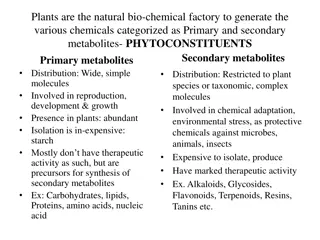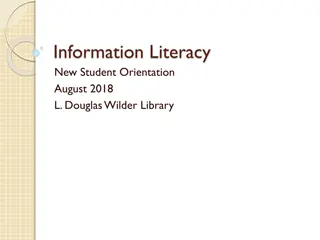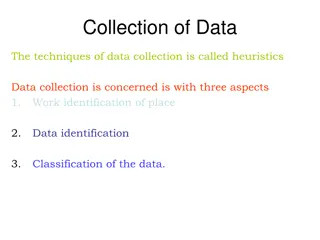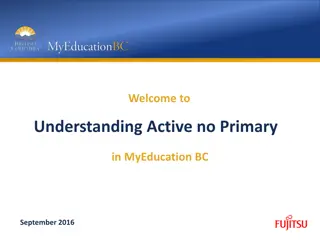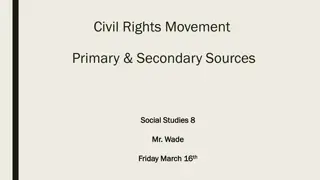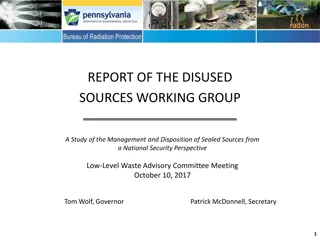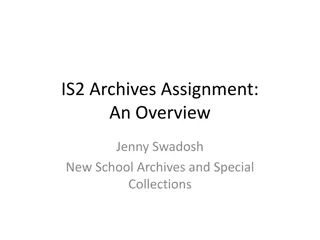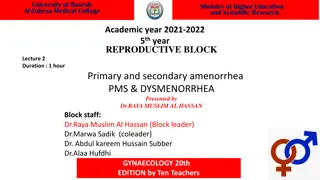Understanding Primary and Secondary Sources in Research
Primary sources provide firsthand information from the time period being studied, while secondary sources offer interpretations based on primary sources. Examples of primary sources include autobiographies, speeches, historical documents, published firsthand accounts, and sound recordings. Secondary sources are accounts written after the fact, providing a secondhand perspective on events or information.
Download Presentation

Please find below an Image/Link to download the presentation.
The content on the website is provided AS IS for your information and personal use only. It may not be sold, licensed, or shared on other websites without obtaining consent from the author. Download presentation by click this link. If you encounter any issues during the download, it is possible that the publisher has removed the file from their server.
E N D
Presentation Transcript
Primary and Secondary Sources What are they?
Primary sources an original document or object; first-hand information. material written or produced in the time period that you may be investigating.
What is a Secondary Source? *A secondhand account based on what some other writer has experienced *Secondary sources are written "after the fact" - that is, at a later date.
Primary Source Autobiographies An autobiography is when you write a story or book about yourself. Example: The Audacity of Hope: Thoughts on Reclaiming the American Dream by Barack Obama
Primary Source Autobiographies An autobiography is when you write a story or book about yourself. Example: By George W Bush
Primary Source Speeches are considered Primary Sources. Examples of Speeches: Abraham Lincoln s Gettysburg Address Martin Luther King s I Have a Dream All of the President s Inauguration Speeches.
Primary Source Historical documents such as the Declaration of Independence or the Constitution are primary documents. They were drafted and signed. Other Primary Sources would be Treaties Birth Certificates Government records Deeds (land) Court documents (marriage) Military records Tax records Census records Art
Primary Source Published first-hand accounts, or stories are considered primary resources. Example: 2008 Presidential candidate Senator John McCain talked about his own experiences as a Vietnam prisoner of war. It is a primary source because he was there, experienced the events and shared it first hand. The television stations found footage of Senator McCain at the time that he was released. Those videos are also considered primary sources because it was filmed when it occurred.
Primary Source Sound Recordings and interviews are considered primary resources. Example 1: During the Great Depression and World War II, television had not been invented yet. The people would often sit around the radio to listen to President Roosevelt s war messages. Those radio addresses are considered primary sources.
Primary Source Photographs and videos are primary sources. Example 1: Photographers during World War II took photographs of battles and/or events during the war. Those photographs are primary sources. Those were taken during actual events. Example 2: The same holds true for videos or film created during an event. A film was made interviewing President Bush. That film would be considered a primary source.
Primary Source Diaries: A daily record, especially a personal record of events, experiences, and observations; a journal. Diaries Example: Anne Frank was a teenager during World War II. She kept a diary or journal the years before she died in a concentration camp. Her diary was later published as the Diary of Anne Frank .
Primary Source Letters are considered primary documents. Example: Soldiers during wars wrote to their families about war events they experienced. Those letters are considered primary sources.
Secondary Source Biography Example: A biography is when you write about another person s life. Alice Fleming wrote a biography on the life of Martin Luther King Jr. This is a secondary document. It was written about him after he died.
Secondary Source Think about it like this . If I tell you something, I am the primary source. If you tell someone else what I told you, you are the secondary source. Secondary source materials articles in newspapers magazines books or articles found that evaluate or criticize someone else's original research
Secondary Source Almanacs, encyclopedias, history books (textbooks), etc. are all secondary sources because they were written after these events occurred.
Primary or Secondary A book written by John Hoyt Williams about Sam Houston, the Father of Texas.
Primary or Secondary Travis Letter
Primary or Secondary The Baseball Almanac is filled with awards, records, stats, quotes, facts and a book full of baseball history.
Primary or Secondary Texas Declaration of Independence
A photograph of the twin towers on 9-11-2001.
Debrief What kind of thinking went on? How do primary sources apply to you? How do secondary sources apply to you? Outside of history, what is another example of a primary source?








